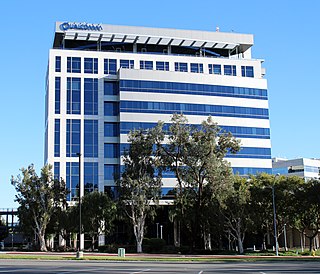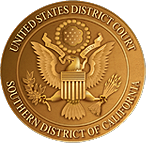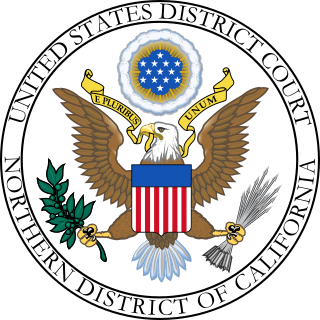
Qualcomm Incorporated is an American multinational corporation headquartered in San Diego, California, and incorporated in Delaware. It creates semiconductors, software and services related to wireless technology. It owns patents critical to the 5G, 4G, CDMA2000, TD-SCDMA and WCDMA mobile communications standards.

Patent infringement is an unauthorized act of - for example - making, using, offering for sale, selling, or importing for these purposes a patented product. Where the subject-matter of the patent is a process, infringement involves the act of using, offering for sale, selling or importing for these purposes at least the product obtained by the patented process. In other words, patent infringement is the commission of a prohibited act with respect to a patented invention without permission from the patent holder. Permission may typically be granted in the form of a license. The definition of patent infringement may vary by jurisdiction.
A declaratory judgment, also called a declaration, is the legal determination of a court that resolves legal uncertainty for the litigants. It is a form of legally binding preventive by which a party involved in an actual or possible legal matter can ask a court to conclusively rule on and affirm the rights, duties, or obligations of one or more parties in a civil dispute. The declaratory judgment is generally considered a statutory remedy and not an equitable remedy in the United States, and is thus not subject to equitable requirements, though there are analogies that can be found in the remedies granted by courts of equity. A declaratory judgment does not by itself order any action by a party, or imply damages or an injunction, although it may be accompanied by one or more other remedies.
The multinational technology corporation Apple Inc. has been a participant in various legal proceedings and claims since it began operation and, like its competitors and peers, engages in litigation in its normal course of business for a variety of reasons. In particular, Apple is known for and promotes itself as actively and aggressively enforcing its intellectual property interests. From the 1980s to the present, Apple has been plaintiff or defendant in civil actions in the United States and other countries. Some of these actions have determined significant case law for the information technology industry and many have captured the attention of the public and media. Apple's litigation generally involves intellectual property disputes, but the company has also been a party in lawsuits that include antitrust claims, consumer actions, commercial unfair trade practice suits, defamation claims, and corporate espionage, among other matters.
In United States patent law, inequitable conduct is a breach of the applicant's duty of candor and good faith during patent prosecution or similar proceedings by misrepresenting or omitting material information with the specific intent to deceive the United States Patent and Trademark Office. A claim of inequitable conduct is a defense to allegations of patent infringement. Even in an instance when a valid patent suffers infringement, a court ruling on an allegation of infringement may exercise its power of equitable discretion not to enforce the patent if the patentee has engaged in inequitable conduct.

Alcatel-Lucent v. Microsoft Corp., also known as Lucent Technologies Inc. v. Gateway Inc., was a long-running patent infringement case between Alcatel-Lucent and Microsoft litigated in the United States District Court for the Southern District of California and appealed multiple times to the United States Court of Appeals for the Federal Circuit. Alcatel-Lucent was awarded $1.53 billion in a final verdict in August 2007 in the U.S. District Court for the Southern District of California in San Diego. The damages award was reversed on appeal in September 2009, and the case was returned for a separate trial on the amount of damages.

James V. Selna is a senior United States district judge of the United States District Court for the Central District of California.

Register.com v. Verio, 356 F.3d 393, was a decision of the United States Court of Appeals for the Second Circuit that addressed several issues relevant to Internet law, such as browse wrap licensing, trespass to servers, and enforcement of the policies of the Internet Corporation for Assigned Names and Numbers (ICANN). The decision upheld the ruling of a lower court which prevented a provider of web development services from automatically harvesting publicly available registration data from a domain name registrar's servers for advertising purposes.

Adobe Systems, Inc. v. Southern Software, Inc. was a case in the United States District Court for the Northern District of California regarding the copyrightability of digitized typefaces. The case is notable since typeface designs in general are not protected under United States copyright law, as determined in Eltra Corp. v. Ringer. Since that case, the United States Copyright Office has published policy decisions acknowledging the registration of computer programs that generate typefaces. In this case, the court held that Adobe's Utopia font was protectable under copyright and Southern Software, Inc.'s Veracity font was substantially similar and infringing.

Trademark infringement is a violation of the exclusive rights attached to a trademark without the authorization of the trademark owner or any licensees. Infringement may occur when one party, the "infringer", uses a trademark which is identical or confusingly similar to a trademark owned by another party, especially in relation to products or services which are identical or similar to the products or services which the registration covers. An owner of a trademark may commence civil legal proceedings against a party which infringes its registered trademark. In the United States, the Trademark Counterfeiting Act of 1984 criminalized the intentional trade in counterfeit goods and services.
TiVo Inc. v. EchoStar Corp. is a case stretching from 2004 to 2011, which took place in the United States District Court for the Eastern District of Texas and the United States Court of Appeals for the Federal Circuit. TiVo Inc. sued EchoStar Corp. claiming patent infringement of a DVR technology. The issues addressed during litigation included patent infringement, wording of injunctions, infringing product redesign, contempt of court orders, and contempt sanctions. Ultimately, the court held that EchoStar Corp. had indeed infringed TiVo Inc's patent and was in contempt of court for noncompliance of an injunction. The parties reached a settlement wherein EchoStar Corp. paid TiVo Inc. a licensing fee. Further, the court replaced the established contempt test with a single step test. The simplified test makes it more difficult for patent holders to prove contempt as a result of repeat infringement.
Motorola Mobility v. Apple Inc. was one of a series of lawsuits between technology companies Motorola Mobility and Apple Inc. In the year before Apple and Samsung began suing each other on most continents, and while Apple and High Tech Computer Corp. (HTC) were already embroiled in a patent fight, Motorola Mobility and Apple started a period of intense patent litigation. The Motorola-Apple patent imbroglio commenced with claims and cross-claims between the companies for patent infringement, and encompassed multiple venues in multiple countries as each party sought friendly forums for litigating its respective claims; the fight also included administrative law rulings as well as United States International Trade Commission (ITC) and European Commission involvement. In April 2012, the controversy centered on whether a FRAND license to a components manufacturer carries over to an equipment manufacturer incorporating the component into equipment, an issue not addressed in the Supreme Court's default analysis using the exhaustion doctrine in Quanta v. LG Electronics. In June 2012, appellate judge Richard Posner dismissed the U.S. case with prejudice and the parties appealed the decision a month later.
Apple Inc. v. Samsung Electronics Co., Ltd. is the general title of a series of patent infringement lawsuits between Apple Inc. and Samsung Electronics in the United States Court system, regarding the design of smartphones and tablet computers. Between them, the two companies have dominated the manufacturing of smartphones since the early 2010s, and made about 40% of all smartphones sold worldwide as of 2024. In early 2011, Apple initiated patent infringement lawsuits against Samsung, who typically responded with countersuits. Apple's multinational litigation over technology patents became known as part of the smartphone wars: extensive litigation and fierce competition in the global market for consumer mobile communications.
Uniloc USA, Inc. v. Microsoft Corp., 632 F.3d 1292, was a patent lawsuit originally filed in the U.S. District Court for the District of Rhode Island.
Finjan, Inc. v. Secure Computing Corp., 626 F.3d 1197 (2010), was a patent infringement case by the United States Court of Appeals for the Federal Circuit involving "proactive scanning" technology for computer security. The Federal Circuit made a mixed decision after hearing the appeals from both sides. In terms of infringement, the Federal Circuit affirmed Secure Computing's infringement on Finjan's system and storage medium patent claims but reversed the infringement on Finjan's method claim. In terms of damage award, the Federal Circuit not only affirmed the previous $9.18 million award by the United States District Court for the District of Delaware, but also remanded for the district court to assess the extra damages between the post-judgement and pre-injunction period.

The Copyright Remedy Clarification Act (CRCA) is a United States copyright law that attempted to abrogate sovereign immunity of states for copyright infringement. The CRCA amended 17 USC 511(a):
In general. Any State, any instrumentality of a State, and any officer or employee of a State or instrumentality of a State acting in his or her official capacity, shall not be immune, under the Eleventh Amendment of the Constitution of the United States or under any other doctrine of sovereign immunity, from suit in Federal Court by any person, including any governmental or nongovernmental entity, for a violation of any of the exclusive rights of a copyright owner provided by sections 106 through 122, for importing copies of phonorecords in violation of section 602, or for any other violation under this title.
Walker Process Equipment, Inc. v. Food Machinery & Chemical Corp., 382 U.S. 172 (1965), was a 1965 decision of the United States Supreme Court that held, for the first time, that enforcement of a fraudulently procured patent violated the antitrust laws and provided a basis for a claim of treble damages if it caused a substantial anticompetitive effect.
JVC Kenwood Corp. v. Nero, Inc., 797 F.3d 1039, 2015 U.S. App. LEXIS 14402, is a 2015 decision of the United States Court of Appeals for the Federal Circuit concerning the rights of end users who purchase products subject to fair, reasonable, and nondiscriminatory (FRAND) licensing under an industry-wide patent pool of standards-essential patents, and of suppliers of software to the end users. The Federal Circuit held that, where the patent holder had authorized sales to end users of optical discs compliant with the standard, which embodied the patents' essential features and were reasonably intended only to be used to practice the patents, the patent owner had no direct infringement claim against the end users without proof that the end-users were using unlicensed discs. The patent holder therefore had no claim for contributory infringement or induced infringement against a software company for selling software to the end users for use with the licensed discs. The decision is said to be an important one for clarifying the rights of downstream users and their suppliers in the context of patent pools and FRAND licensing.
Halo Electronics, Inc. v. Pulse Electronics, Inc., 579 U.S. 93 (2016), was a United States Supreme Court case in which the Court held that the two-part Seagate test, used to determine when a district court may increase damages for patent infringement, is not consistent with Section 284 of the Patent Act.

Czarnik v. Illumina Inc., 437 F. Supp. 2d 252, was a United States patent law case heard before the United States District Court for the District of Delaware. In its ruling, the district court was the first court to hold that reputational harm could be sufficient to establish standing in an action for correction of named inventor under 35 U.S.C. § 256. That ruling led to a split among district courts that has yet to be definitively resolved.








